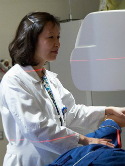| Abstract: |
Background: Completion axillary lymph node dissection (CALND) is routinely performed in breast cancer patients with positive sentinel lymph nodes (SLN). We sought to determine the sociodemographic, pathologic, and therapeutic variables that were associated with CALND. Methods: From 7/1997 to 7/2003, 1,470 patients with invasive breast cancer were SLN positive by intraoperative frozen section or final pathologic exam by hematoxylin-eosin and/or immunohistochemistry (IHC). A comorbidity score was assigned using Adult Comorbidity Evaluation-27 system. Fisher's exact, Wilcoxon tests, and multivariate logistic regression analysis were used. Results: CALND was performed less often in patients with age ≤ 70 years compared with age < 70 years, moderate or severe comorbidities compared with no or mild, IHC-only positive SLN and breast conservation therapy (BCT compared with mastectomy. Patients who did not undergo CALND were less likely than CALND patients to have grade III disease, lymphovascular invasion multifocal disease, tumor size > 2 cm or to receive adjuvant chemotherapy. However, they were more likely to undergo axillary radiotherapy (RT). On multivariate analysis, age ≤ 70 years [odds ratio (OR) 0.4, 95% confidence interval (CI) 0.26-0.63], IHC-only positive SLN (OR 0.13, 95%CI 0.09-0.19), presence of moderate to severe comorbidities (OR 0.64, 95%CI 0.41-0.99), tumor size ≥ 2 cm (OR 0.44, 95%CI 0.29-0.66), axillary RT (OR 0.39, 95%CI 0.20-0.78), and BCT (OR 0.54, 95%CI 0.37-0.79) were all independently associated with lower odds of CALND. Conclusions: The decision to perform CALND following positive SLN biopsy was multifactorial. Patient factors were a primary determinant for the use of CALND in our study. The decreased use of CALND in the BCT patients probably reflects reliance on the radiotherapy tangents to maintain local control in the axilla. © 2009 Society of Surgical Oncology. |










